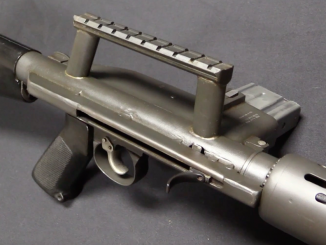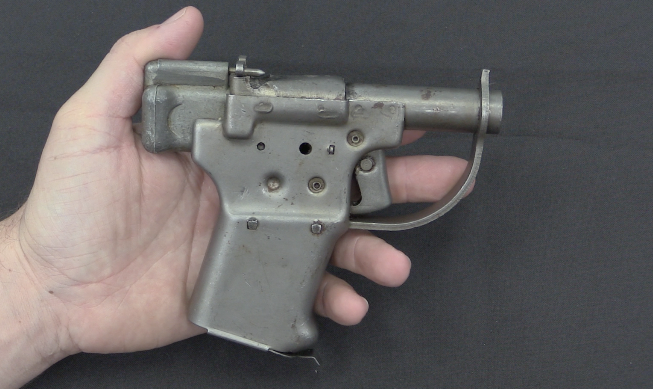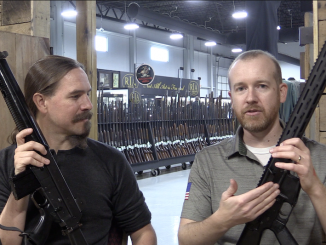Guns in this video:
DWM 1917 Baby Luger
American Eagle Baby Luger
P08 .45ACP Luger
Navy .45ACP Luger
Luger Carbine
John Martz was a WWII US Navy veteran who spent a career in metalworking before turning his gunsmithing hobby into a full time occupation in the 1960s. He is best known for his custom Luger pistols, and today we have a selection of them to take a look at. They fall into three main categories – carbines, baby Lugers, and caliber conversions. Most notable of the caliber conversions are his .45 ACP guns, made by cutting a Luger frame in two and widening it (plus extensive work to convert the upper assembly parts). With the extremely scarcity and value of original DWM .45ACP Lugers, Martz’s conversions are quite sought after.




They don’t make P08’s like they used to back when each gun was a custom job. And a good Luger fed proper ammunition is practically mud-proof!
Martz was an amazing craftsman, and his Martz Safe Toggle Release (MSTR) safety was something the Parabellum should have had from the outset.
But I never saw much point in a .45 ACP Luger. Sorry, but the 9 x 19mm and .45 ACP deliver almost exactly the same KE to the target. And the .45 magazine holds one less round than the 9mm does.
Yes, I think the U.S. Army should have adopted the 9 x 19mm in 1911, and saved themselves several wars’ worth of aggravation. In fact, if John Browning had had his way at the time, we’d today be calling the P35 High Power the “Colt Model of 1911 .38 Caliber Pistol, Government Model”.
And NB; I carried a .45, in Colt and S&W persuasions, on duty for quite a while. (Mainly because we weren’t allowed to load .357 Magnums with….357 Magnum ammunition.)
cheers
eon
“In fact, if John Browning had had his way at the time, we’d today be calling the P35 High Power the “Colt Model of 1911 .38 Caliber Pistol, Government Model”.”
Dubious, speaking mildly. To be honest High Power should be called Saive, even if FN choose Browning (possibly for marketing reason).
According to https://en.wikipedia.org/wiki/Dieudonné_Saive
The very first event in this automatic pistol timeline was French requirements from 1921. Adapting automatic pistol 10 years before creating requirements. How? Moreover Browning himself was unenthusiastic about development of that automatic pistol. Also remember that High-Power wasn’t big marketing success from start, it was sold to some smaller armies, including Belgian, but not in awe-inspiring numbers. It earn popularity during World War II.
“U.S. Army should have adopted the 9 x 19mm in 1911”
I wouldn’t be so sure if exactly this cartridge should be adopted, but found .45 Auto choice not optimal.
Browning himself designed automatic pistol known as Husqvarna pistol m/1907
http://www.gotavapen.se/gota/m07/pist07_3.htm
which use 9×20 SR Browning Long cartridge, so I presume Browning might would use this cartridge if given freedom in that regard.
It is worth noting that in similar time to U.S. work, that is 1900s-1910s only two European countries adopted automatic pistol of similar caliber: Norway, in form of Colt Kongsberg and Great Britain in form of Webley-Scott automatic pistol, which anyway would never fully replace Webley top-break revolvers.
I’m pretty sure the 45 caliber was chosen because of black powder beliefs. Any handgun with a smaller cartridge was considered less than capable of causing instant debilitating physical trauma inflicted in such a manner that intended victims instantly dropped dead. Why? Experience from fighting crazed Moros. Penetration is not equivalent to incapacitation unless you shoot said crazed targets point blank with solid shot fired from a field gun and get multiple victims all at once. I hope I could be wrong!
Actually, in the U.S Army, the pistol was still seen primarily as a cavalry weapon. Therefore, its main purpose was “stopping” not a man, but a horse.
The Colt Model 1873 Single Action Army Revolver, and its .45 caliber cartridge, had been designed to drop an enemy cavalryman’s horse as quickly as possible, preferably with one shot to the heart/lung area. The Ordnance Board insisted on a self-loading pistol that could safely be used one-handed by a cavalryman (thus the grip safety) and have enough killing power to bring down a horse. The Moros had little or nothing to do with it.
The supposedly “brutal” bullock killing tests conducted by then-Col. Julian S. Hatcher for the Thompson-LaGarde Committee make perfect sense in this context. If you want to know how to kill a horse, you experiment on something as much like a horse as possible, but cheaper, preferably something that’s going to be killed anyway. Slaughterhouse beeves were the obvious answer.
Although interestingly, the only “One-Shot stop” recorded during the entire test series was when Hatcher inadvertently shot one bullock right through the aorta. With a 7.65 x 21mm Parabellum (.30 Luger) full-metal-jacket slug.
If the tests proved anything, they proved that;
1. There is little difference in the effects of pistol bullets of similar kinetic energy on live targets.
2. There is probably no such thing as a “One-Shot Stop” with any handgun round.
Which sort of makes nonsense of the entire “Hatcher Theory of Stopping Power”. And the rationale for the .45 ACP cartridge, Jeff Cooper notwithstanding.
Of course, it may also simply prove that as Ken Warner once said of deer re “deer rifle” cartridges, bullocks may simply be unable to read ballistics charts.
cheers
eon
Excellent points, American military sidearms, from the Walker Colt to the 1911, have always been intended for use on enemy horses.
In that time many other European countries adapted 9 mm cartridge, though of various case shape/volume and also muzzle velocity. Examples:
Italy takes 9×17 Browning (.380 Auto)
Sweden takes 9×20 SR Browning Long
Austria-Hungary takes 9×23 Steyr (this is different entity that Spanish 9×23)
Spain takes 9×23 Largo.
The Italians adopted the 9×19 Glisenti in 1910. They went for the .380 after WW1.
Right, 9×19 Glisenti cartridge is interesting case – taming existing cartridge.
It dawned on them that the 9 x 19mm Glisenti was basically a .38 Special load in a 9mm Parabellum case, to be used in pistols designed for .38 Special level breech pressures. While certainly enough to get the job done, there was a serious danger that somebody might get a 9mm Parabellum round into a blowback Glisenti-chambered pistol, with unfortunate or even deadly consequences.
This was made even more likely by the fact that the Beretta Model 1938 submachine gun was in inventory, along with the earlier OVP SMG, and both used a 9mm P “carbine” load that was even hotter that standard 9 x 19mm, with ballistics and pressures in the range of the American .357 Remington Magnum revolver cartridge, at the time the most powerful (and highest-pressured) handgun round on Earth.
One of these could make a Beretta Model 1915 blowback auto, or a Brixia or Glisenti retarded-blowback, do an excellent- and lethal- impression of a fragmentation grenade.
Seen in this light, issuing a new Beretta pistol that was functionally identical to the old reliable Model 1915, but chambered for a round that was not dimensionally identical to 9 x 19mm Parabellum, made pretty good sense. Try as you might, you can’t chamber and fire a 9 x 19mm in a 9 x 17mm (aka .380 ACP) chamber.
As a bonus, it was smaller and lighter than the old “boat anchor”, and its 9mm Corto round got about the same results at the receiving end as the 9mm Glisenti. For that matter, the 7.65mm Browning version was about as good a man-killer as the .380 version was.
Altogether for their purpose, the Beretta Model 1934 family of pistols were a good idea. Not to mention a good bit safer than their predecessors.
cheers
eon
From what I have read, the smaller and lighter part was actually the main reason for adopting the .380 ACP in the Italian Royal Army. In 1934 there were no full power 9mm Parabellum cartridges in Italian inventory, let alone the hot-loaded ones developed specifically for the Beretta MAB 38. Furthermore, the Italian Army adopted the MAB 38 only in December 1941. Before that it was used only by the Carabinieri and other police and paramilitary units.
The preference for lighter pistols makes perfect sense considering that pistols were used mostly by officers. Enlisted men who required a more compact weapon than a rifle were given the Moschetto per Truppe Speciali carbines (or “musketoons”) with a short 450mm barrel. Thanks to the 6.5mm cartridge, these were quite okay weapons to shoot, unlike similar weapons chambered in more powerful cartridges, such as the M44 Mosin.
“.357 Remington Magnum”
Something is wrong there. Shouldn’t be .357 S&W Magnum? There existed .357 Remington Maximum but this is other cartridge, but it appeared in 1980s.
Daweo; eon was probably thinking about the .44 Magnum, which was indeed first introduced by Remington commercially.
The Italian 9×19mm SMG ammo wasn’t quite as hot as .357 Magnum. Muzzle velocity for a 123 grain projectile was 1300-1350 fps from a pistol barrel, which is similar to modern American overpressure 9mm +P+ loadings or average .357 SIG. Classic .357 Magnum is about 1450 fps with a 125 grain bullet.
Italy adopted the 9mm Glisenti in 1910, but the 9×17mm Browning only in 1934. The first European country to officially adopt he latter was Yugoslavia in 1922, I believe.
Denmark also adopted the 9×23mm “Largo” with the M1910 Bergmann-Bayard pistol, although they of course did not use the Spanish “Largo” nickname.
“The first European country to officially adopt he latter was Yugoslavia in 1922, I believe.”
There was also Czechoslovak cartridge 9mm vz. 22 which if I understand correctly: http://csopevneni.xf.cz/Vybava/9mm%20vz_22/9mm%20vz22.htm
is dimensionally same as 9×17 Browning, but loaded hotter. Should it be treated as subset of 9×17 Browning or as separate one? vz. 22 imply 1922 as year of adoption.
9mm Frommer was also a hot-loaded variant of 9×17 Browning, but I have been unable to find ballistic data for it. It was not used by the Hungarian Army as far as I know.
If the US had adopted a .38 service pistol, it would have most likely have been chambered for the .38 ACP cartridge. 9mm Browning Long was Browning’s idea for an inexpensive full size service pistol with a simple blowback action. It didn’t get much popularity, because most European armies looking for a new blowback service pistol considered the 9mm Browning Short (aka .380 ACP) sufficiently powerful. It enabled lighter and more compact guns, and had the additional advantage of being truly rimless.
The Webley-Scott automatic pistol was never adopted by the British Army and therefore didn’t really even start to replace the Webley revolvers. As witnessed by the adoption of a new break-open revolver in .380/200 chambering in the 1930s, the British Army was apparently quite satisfied with six shooters. They didn’t even bother to increase the capacity, even though it would have been fairly straightforward to do with 1930s manufacturing technology, especially for such a low pressure cartridge.
As for why the .380in was adopted, my SWAG is that somebody actually read a ballistics chart.
The .380in (.38 S&W) British service load, with a 200 grain bullet at 650 feet per second, has a muzzle energy of 190 foot pounds. The old 0.455in Webley, with a 265 grain bullet at 600 F/S, has a ME of 220 foot-pounds.
They probably concluded that they could give up 30 foot pounds of energy in return for a lighter weapon that non-Territorials could actually be taught to hit something with.
cheers
eon
“actually read a ballistics chart”
According to https://en.wikipedia.org/wiki/.38/200
In tests performed on cadavers and live animals, it was found that the lead bullet, being overly long and heavy for its calibre, become unstable after penetrating the target, somewhat increasing target effect.
Thus, this cartridge it initial iteration, has got effect from bullet losing stability after hit, however later it was found to be illegal as bullet could expand or flatten easily in the human body, thus leading to new Mk II version with FMJ bullet (180 gr) was introduced.
British Army was a supporter of the “bigger is better” theory prior to WW1, which is why they didn’t even seriously consider anything smaller than .45 caliber. This was borne out of their extensive experience in colonial wars. While the US insistence on .45 may have had much to do with the Moro rebellion, the British had found the .455 Webley to be quite effective against tribal warriors and they were not willing to risk using a smaller diameter bullet.
However, during WW1 they found out that training conscripts with no experience on pistol shooting with the .455 Webley was quite a challenge. The .38 S&W had much less recoil, but the British were not satisfied with the wounding effect of the traditional 145 grain ammo.
“British Army was a supporter of the “bigger is better” theory prior to WW1, which is why they didn’t even seriously consider anything smaller than .45 caliber”
Additionally older revolver cartridge were compatible with newer one, for example .455 Webley revolver will accept .450 Boxer Mk I cartridges. As Empire was vast in area and transport to remote parts took long time, this might be useful feature.
Also notice that .455 Webley was loaded with cordite – I don’t know how it would perform in smaller caliber cartridge.
. Don’t take my word for it though. Here’s what the FBI had to say in 1987:
Kinetic energy does not wound. Temporary cavity does not wound. The much discussed “shock” of bullet impact is a fable and “knock down” power is a myth. The critical element is penetration. The bullet must pass through the large, blood bearing organs and be of sufficient diameter to promote rapid bleeding. Penetration less than 12 inches is too little, and, in the words of two of the participants in the 1987 Wound Ballistics Workshop, “too little penetration will get you killed.”42, 43 Given desirable and reliable penetration, the only way to increase bullet effectiveness is to increase the severity of the wound by increasing the size of hole made by the bullet. Any bullet which will not penetrate through vital organs from less than optimal angles is not acceptable. Of those that will penetrate, the edge is always with the bigger bullet.44
do you know if the guy who took over John Martz’s gun smiting business is still doing German Lugar pistol conversions to carbines??
The American preference for large bore pistols goes back at least to the Texas Rangers. They liked the Paterson Colt in .36, but asked for something larger, something that could bring down enemy horses. Colt built them the .44 Walker Colt.
Amazing craftsmanship. Sheet metal work may look simple, but laying out sheet metal so it folds up properly in three-dimensions from a front/top/side view two-dimension drawing takes a lot of skill. A person who was really good at that sort of thing might be good at visualizing what all was going on in a complex pistol.
Regarding why someone would be interested in a 45 Luger, disregarding personal opinions about terminal ballistics, 45 ACP was highly available in the US when 9mm was not available in every country hardware store.
Much worry about what would be the ‘right’ cartridge for military side arms. Has any armed clash been decided by who had the best pistol?
I read someone’s comment about the 1911: ‘You’ll probably never need it, but when you do, you’ll need it bad.’
“Has any armed clash been decided by who had the best pistol?”
I don’t know, but I want to note that in environment of trench warfare during Great War, pistols were widely used, as long rifles were not best suited in usage of confined spaces of trenches. See: https://www.forgottenweapons.com/british-pistol-use-during-wwi/
Pistols are backup weapons in the modern context. So, you’re right, there really is not much point about discussing the best pistol cartridge from a strategic viewpoint. Nevertheless, it’s a discussion many people have a strong opinion on, so it gets repeated quite often. I find it interesting to compare different philosophies different armies had on pistols, revolvers and their cartridges in the smokeless powder era. Nowadays of course the 9mm Parabellum and full size double stack service pistol are nearly ubiquitous; only the Chinese seem to resist it’s lure.
Sometime in the 1982 to 1984 period, and guns and ammo annual was supposed to have an article on a luger converted to .38 super.
I never managed to get hold of the magazine. Availability in Britain at the time was sketchy at best, and very expensive for the info it contained, even beforeit began to cater almost exclusively for the hard of thinking.
At a time when American 9mmp was loaded to glisenti pressure levels and had difficulty in cycling and luger (and of course,the fe’ral state was founded to have high tarriffs to screw over American consumers and deny them the choice of imports), a super conversion might have been a (labour intensive ) way to get a luger to shoot.
Years ago, I read an article that said that Browning’s favorite caliber was .32 ACP. He supposedly carried pistols in this caliber for his PDW. Wish I could remember where and when that article was published. Or even if I remember it correctly.